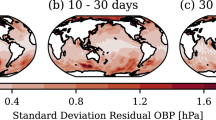Abstract
The GRACE (gravity recovery and climate experiment) and GOCE (gravity field and steady-state ocean circulation explorer) dedicated gravity satellite missions are expected to deliver the long-wavelength scales of the Earth’s gravity field with extreme precision. For many applications in Earth sciences, future research activities will have to focus on a similar precision on shorter scales not recovered by satellite missions. Here, we investigate the signal power of gravity anomalies at such short scales. We derive an average degree variance and power spectral density model for topography-reduced gravity anomalies (residual terrain model anomalies and de-trended refined Bouguer anomalies), which is valid for wavelengths between 0.7 and 100 km. The model is based on the analysis of gravity anomalies from 13 test regions in various geographical areas and geophysical settings, using various power spectrum computation approaches. The power of the derived average topography-reduced model is considerably lower than the Tscherning–Rapp free air anomaly model. The signal power of the individual test regions deviates from the obtained average model by less than a factor of 4 in terms of square-root power spectral amplitudes. Despite the topographic reduction, the highest signal power is found in mountainous areas and the lowest signal power in flat terrain. For the derived average power spectral model, a validation procedure is developed based on least-squares prediction tests. The validation shows that the model leads to a good prediction quality and realistic error measures. Therefore, for least-squares prediction, the model could replace the use of autocovariance functions derived from local or regional data.
Similar content being viewed by others
References
Arabelos D, Tscherning CC (2003) Globally covering a-priori regional gravity covariance models. Adv Geosci 1:143–147
Flury J (2002) Schwerefeldfunktionale im Gebirge – Modellierungsgenauigkeit, Messpunktdichte und Darstellungsfehler. Deutsche Geodätische Kommision C 557, Munich
Forsberg R (1984a) A study of terrain reductions, density anomalies and geophysical inversion methods in gravity field modelling. Report 355, Department of Science Ohio State University, Columbus
Forsberg R (1984b) Local covariance functions and density distributions. Report 356, Department of Science, Ohio State University, Columbus
Forsberg R (1986) Spectral properties of the gravity field in the nordic countries. Bollettino di Geodesia e scienze affini XLV(4):361–384
Forsberg R, Tscherning CC (1981) The use of height data in gravity field approximation by collocation. J Geophys Res 86(B9):7843–7854
Forsberg R, Tscherning CC (1997) Topographic effects in gravity field modelling for BVP. In: Sansò F, Rummel R (eds). Geodetic boundary-value problems in view of the one centimeter geoid. Lecture notes in earth sciences, vol 65, Springer, Berlin Heidelberg New York, pp 241–272
Gelb A (eds). (1974) Applied optimal estimation. The Analytic Sciences Corporation, MIT Press, Cambridge
Goad CC, Tscherning CCT, Chin MM (1984) Gravity empirical covariance values for the continental United States. J Geophys Res 89(B9):7962–7968
Hofmann-Wellenhof B, Moritz H (1986) Introduction to spectral analysis. In: Sünkel H (eds). Mathematical and numerical techniques in physical geodesy. Lecture notes in earth sciences, vol 7. Springer, Berlin Heidelberg New York
Jekeli C (1978) An investigation of two models for the degree variances of global covariance functions. Report 375, Department of Science Ohio State University, Columbus
Kasper JF (1971) A second-order Markov gravity anomaly model. J Geophys Res 76(32):7844–7849
Kaula WM (1966) Theory of satellite geodesy. Blaisdell, Massachusetts
Kenyon S, Pavlis N (2004) Status and plans for geopotential model EGM05. Presentation at the gravity, geoid and space missions symposium GGSM2004, Porto
Knudsen P (1987) Estimation and modelling of the local empirical covariance function using gravity and satellite altimeter data. Bullet Géodésique 61(2):145–160
Lemoine FG, Kenyon SC, Factor JK, Trimmer RG, Pavlis NK, Chinn DS, Cox CM, Klosko SM, Luthcke SB, Torrence MH, Wang YM, Williamson RG, Pavlis EC, Rapp RH and Olson TR (1998) The development of the joint NASA GSFC and NIMA geopotential model EGM96. NASA Goddard Space Flight Center, Greenbelt, Maryland
Marple SL (1987) Digital spectral analysis with applications. Prentice Hall, Englewood Cliffs
Rapp RH (1979) Potential coefficient and anomaly degree variance modelling revisited. Report 293 Department of Science Ohio State University, Columbus
Schwarz KP (1985) Data types and their spectral properties. In: Schwarz KP (ed) Local gravity field approximation, Proceedings of Beijing International Summer School 1984, University of Calgary
Shichi R, Yamamoto A (2001) Gravity database of southwest Japan (CD-ROM). Special Report 9 Bull, Nagoya University Museum, Nagoya
Strykowski G (1996) Improving the planar isotropic covariance models. In: Jacobsen BH, Mosegaard K, Sibani P (eds). Inverse methods, interdisciplinary elements of methodology, computation, and applications, lecture notes in Earth Sciences, Vol. 63. Springer, Berlin Heidelberg, New York, pp 254–261
Torge W (2001) Geodesy, 3rd edn. De Gruyter, Berlin
Tscherning CC (1985) Local approximation of the gravity potential by least squares collocation. In: Schwarz KP (ed) Local gravity field approximation. In: Proceedings of Beijing International Summer School 1984, University of Calgary
Tscherning CC, Rapp RH (1974) Closed covariance expressions for gravity anomalies, geoid undulations, and deflections of the vertical implied by anomaly degree variance models. Report 208, Department of Geodesy Science Ohio State University, Columbus
Wenzel HG (1999) Schwerefeldmodellierung durch ultra-hoch-auflösende Kugelfunktionsmodelle. Zeitschrift für Vermessungs-wesen 124(5):144–153
Wenzel HG, Arabelos D (1981) Zur Schätzung von Anomalie-Gradvarianzen aus lokalen empirischen Kovarianzfunktionen. Zeitschrift für Vermessungswesen 106:234–243
Author information
Authors and Affiliations
Corresponding author
Rights and permissions
About this article
Cite this article
Flury, J. Short-wavelength Spectral Properties of the Gravity Field from a Range of Regional Data Sets. J Geodesy 79, 624–640 (2006). https://doi.org/10.1007/s00190-005-0011-y
Received:
Accepted:
Published:
Issue Date:
DOI: https://doi.org/10.1007/s00190-005-0011-y




